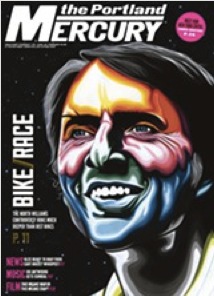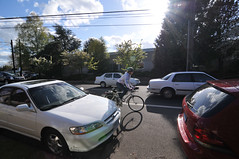
PBOT’s North Williams Traffic Operations Safety Project is heating up again — both the public process and the public spotlight.
The project found its way onto the cover of this week’s edition of The Portland Mercury. Reporter Sarah Mirk took a historical look at the Albina neighborhood and, given its history of racism and development, she arrived at the conclusion that the project is “Not about the bikes.”
Here’s a key quote in Mirk’s story that I think sums up feelings of some people in the community. It comes from Midge Purcell, policy director of the Urban League of Portland (a non-profit that advocates for African Americans):
“The City of Portland’s policies want to encourage increased cycling and environmental friendliness,” she continues. “That’s all very well and good. But when people feel that those values are imposed upon them, especially when there’s been all the other historic impositions on the community, then it really does become about a lot more than just putting in a bicycle lane. In a lot of ways, this is a real test. To see whether some of the lessons have been learned from previous projects where the outcomes have been really, really poor.”
Bicycling Magazine also has a freelancer working on a story about the project. I’ve been in contact with him and last week went on a ride with the reporter, stakeholder advisory committee (SAC) member Michelle DePass, and PBOT project manager Ellen Vanderslice (who by the way is retiring on April 27th).
Speaking of outcomes for this project, the project’s SAC adopted their “Top Ten Outcomes and Measures” at a meeting on February 7th. Having the entire, 26-member SAC agree to a set of outcomes is a key tool the group will use to evaluate potential engineering solutions.
Interestingly, while concerns about motor vehicle parking capacity and increased congestion have been a part of opposition toward reducing the street to one standard vehicle lane, none of the outcomes related to those issues were adopted onto the top ten list.
Previous drafts of the outcomes list included items such as: “Motor vehicle congestion in the corridor is not significantly increased,” “Average travel times for motor vehicles during peak hours is not significantly increased,” and “The supply of on-street motor vehicle parking in the project corridor is maintained.”
If any of those outcomes would have been adopted, it would have constrained the SACs ability to recommend certain solutions — especially a solution that included less road space for motor vehicles. Instead, the adopted outcomes set the stage for a SAC recommendation that favors safety of humans over convenience of private vehicle travel.
Here is a list of the top ten desired outcomes:
- Increase convenient pedestrian opportunities to safely cross Williams
- Mitigate conflicts between all modes
- Reduce motor vehicle speeds
- Improve visibility of pedestrians
- Reduce the risk of cyclists being struck by opening vehicle doors
- Create opportunities for people bicycling to pass other cyclists without entering the motor vehicle travel lane
- Manage conflict between bus and bicycle operations
- Reduce all crashes in the N Williams corridor
- Maintain or improve ease of transitions bicyclists making turns
- Maintain access and operability for TriMet LIFT vehicles and private lift‐equipped vans
The SAC is just days away from putting some actual engineering designs through their filter of outcomes. Speaking at the PBOT Bicycle Advisory Committee on Tuesday, City Traffic Engineer Rob Burchfield said he plans to share four “conceptual options for improvements” with the SAC this week.
“The goal is to bring the process to a close before the end of the fiscal year [June 30th].”
— Rob Burchfield, PBOT
The SAC has met monthly since February 2011 (except for July, when the process took a one month breather), but, with the process having dragged on for over a year, the pace is set to quicken. PBOT has announced four extra meetings between now and April 3rd, “In the interest of developing a recommendation… by the summer construction season.”
Whatever recommendation the SAC comes up with, whether or not there’s enough money to pay for them remains to be seen. As Mirk reported in The Mercury article, the entire budget for the project is only $370,000 and 25 percent of it has already gone toward planning and public involvement. That leaves $277,500 for a two mile long project that is likely to include a mix of new paint striping, signage, and crosswalks. New traffic signals have been discussed, but at about $200-250,000 a piece, they are unlikely to be feasible with limited funding.
With money extremely tight at PBOT right now, the agency says they need this process to come to a close before the end of the fiscal year (June 30th). That warning is likely due to a lack of confidence that the money would continue to be available in next year’s budget.
Some have speculated that new development — especially the New Seasons Market — might come with new money in the form of System Development Charges (SDCs). SDCs are fees paid by developers to off-set impacts their new buildings have on the transportation system. However, PBOT told the SAC at their last meeting that SDCs won’t be available for this project (it’s complicated, something about it not being on an already-adopted City Council list and about the Eastside Streetcar and Milwaukie Light Rail projects already sucking up all the available SDC funds).
The SAC meets again this coming Tuesday where, after months of long-winded (yet important) debates about process and principles, they’ll finally be ready to roll up their sleeves and get to work deciding what actual changes to implement. I have a feeling there are some contentious discussions ahead. Just like there were back in May 2011, there are still strong feelings on both sides of the one-lane debate.
Hopefully this time around, given the expanded process and stronger involvement of all parties, the discussion will result in a positive outcome. Stay tuned.


